
ANTONY PRESTON, JOHN BATCHELOR
THE SUBMARINE SINCE 1919
By comparison the US Navy suffered relatively little from Japanese submarine attacks. The battleship North Carolina was torpedoed by 115 in 1942 but survived, as did the carrier Saratoga when hit by 126. The greatest Japanese triumphs took place at Midway when I168 put four torpedoes into the crippled carrier Yorktown, and the sinking of the carrier Wasp by I19 south of the Solomons. The main reason for this was the high degree of skill shown by American anti-submarine forces, as underlined when the destroyer escort England sank six submarines in twelve days in May 1944. But the concentration on warship targets by the Japanese freed the Americans from having to organise a massive convoy system in the Pacific, and released escorts for more urgent duties with the front-line forces.
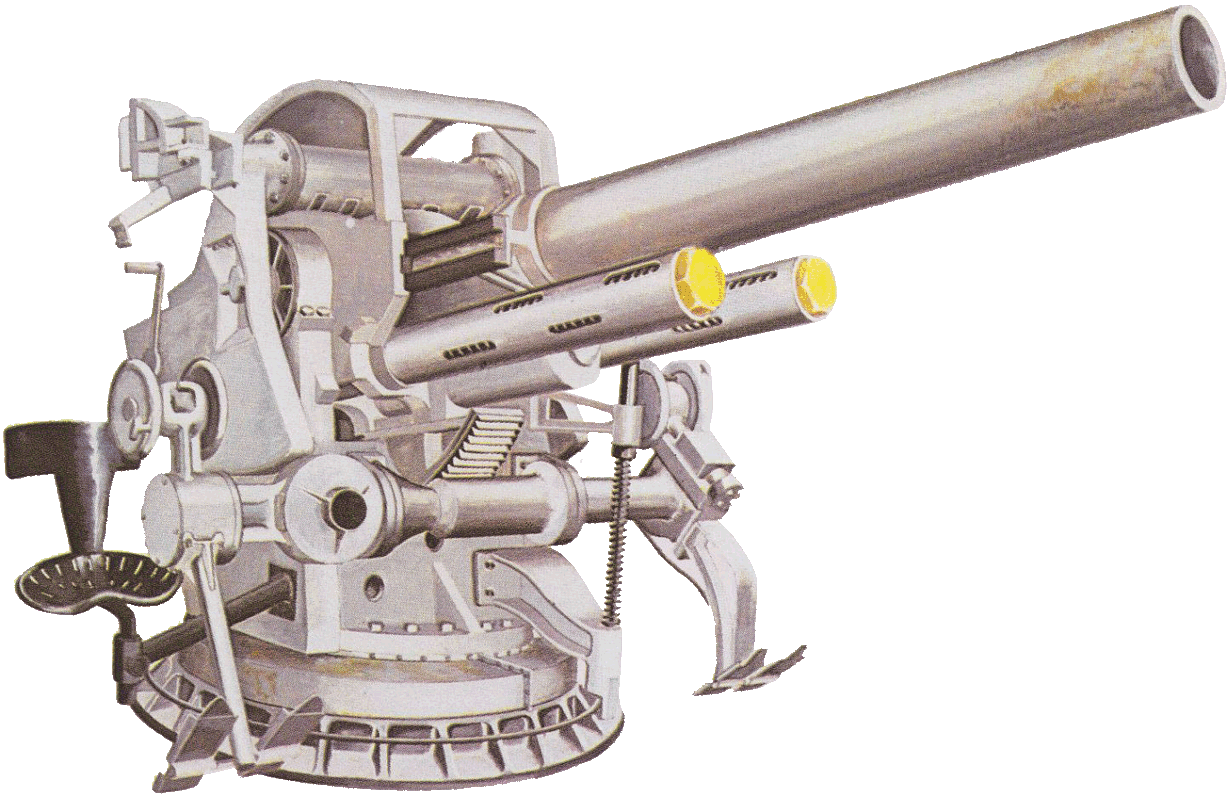
American 5-in Submarine Gun. The 5-in/25 cal. Mk XIII gun shown was mounted on board USS Tigrone (SS419), one of the few Tench Class to be completed before the end of the war. Many weapons were carried by US submarines, but this pattern was the most popular. Weight: 21 tons. Range: 14,500 yards at 40° elevation. Weight of shell: 53 lb
Japanese submarines were well aware of the need to attack American shipping, but failed to get a hearing from their superiors. When things began to go badly in 1942 the response was to hurl submarines into useless attacks on landing forces, or to use them to transport supplies to isolated Army garrisons. Not satisfied with this, the Army began to build transport submarines of its own, surely the most monumental dispersion of effort in the history of naval warfare; about 28 were built, and they were manned by Army personnel. When permission was given to attack communications it was too late, and in any case reliance was placed on the Kaiten, which were hardly suitable for extended operations. Like the Italian "pigs" the Kaiten were transported on the decks of submarines, and were launched when close to the operational area.

Japanese I70. The lack of numerical sequence makes Japanese submarine classes hard to follow; 170's sisters were renumbered I168-169 and I171-172. They were big ocean-going submarines with a range of 14,000 miles on the surface. I70 was sunk by carrier aircraft only three days after the attack on Pearl Harbor. Displacement: 1,785 tons (surfaced). Armament: Six 21-in torpedo-tubes; 14 torpedoes carried; one 3·9-in AA gun; one 13-mm machine-gun. Speed: 23 knots (surfaced), 8¼ knots (submerged)
The last flowering of Japanese submarine design was typically ambitious. In 1942 they ordered 17 of the Type STo, the largest submarines ever seen up to that time. These were the famous 1400 Class, an amalgamation of the Type A, B and C submarines, to produce an aircraft-carrying boat which could attack the Panama Canal. For this purpose they were meant to carry two seaplane bombers, but were altered to carry three in the hangar. In layout they followed the previous big submarines, but to keep the draught down as much as possible a peculiar double cylindrical hull was tried, with the cylinders side-by-side. The armament was heavy, eight 21-in bow torpedo-tubes with 20 reloads, and four torpedoes and 15 bombs carried for the seaplanes.
Only three of these giants were completed by August 1945, when Japan capitulated. When American technical experts examined them they found a lot of evidence of technical assistance from the Germans. Many German U-Boats had made trips out to the Far East to collect cargoes of rubber, tin and wolfram, and the Japanese had been very anxious to copy the features which made these boats so superior to their own. The 1400 Class had a schnorchel, and, even had the same rubber coating on the hull which was being tried out in Germany as a means of absorbing Asdic pulses.

Japanese I402. The I400 Class were ordered under the modified 1942 programme and were the I largest submarines built up to that time. The intention was to provide them with three seaplane bombers in order to attack the Panama Canal, but the aircraft never reached production. Only three boats were completed by August 1945, and they were surrendered to the American occupying forces. Displacement: 5,223 tons (surfaced). Armament: Eight 21-in torpedo-tubes; 20 torpedoes carried; one 5·5-in gun; ten 25-mm AA guns
It would not be correct to suggest that the Japanese submarine effort was only directed towards large submarines, because in one way they anticipated the Germans in developing a boat with high underwater speed. In 1937/38 they built No.71 in conditions of utmost secrecy, even to the point of launching her behind a smokescreen. She was small, only 140 ft long and displacing 213 tons on the surface, but she reached 21 knots under water. Although she never entered service, being nothing more than an experimental boat, she revived the ideas which had been tested and forgotten with the British "R" Class twenty years earlier. During the war two operational classes were built to develop her ideas, the small Ha201 Class and the larger I201s.
Despite these interesting developments the Japanese submarine effort during the Second World War was a costly failure. Losses were extremely heavy; out of 245 submarines which served in the war (excluding ex-German and Italian boats taken over and midgets) 149 were sunk, a loss ratio of 60 per cent. There were few successes to match the exploits of the Germans, largely because the peacetime policy and training had proved totally wrong. The only successes of the aircraft-submarine tactics which the Japanese had developed so diligently came in 1942; a scout plane reconnoitred Diego Suarez harbour before a midget was sent in to torpedo a British battleship and another tried to set the Oregon pine forests alight with incendiary bombs. Otherwise this costly programme was entirely wasted.
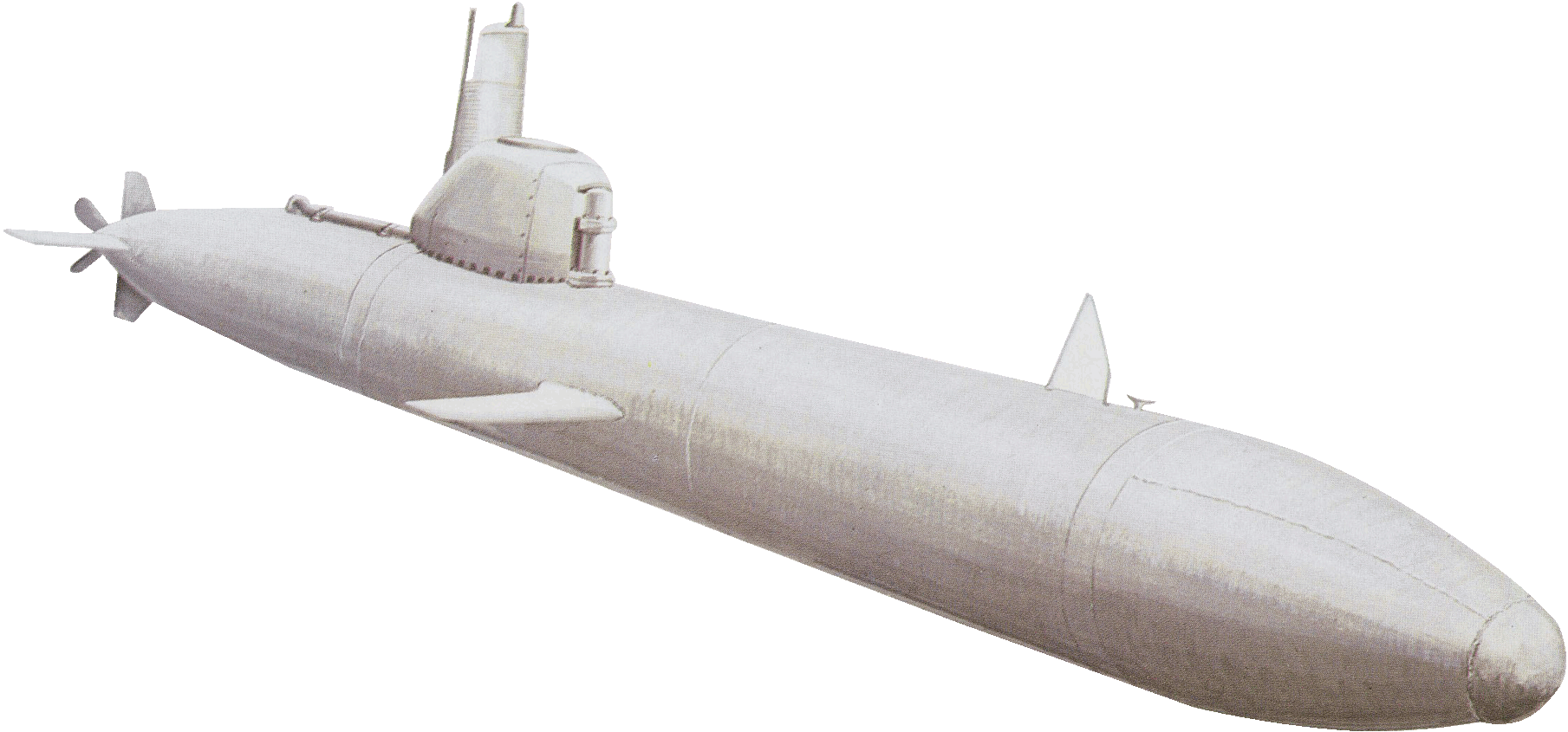
Japanese "Kaiten" Midget. This was the naval equivalent of the Kamikaze, being a piloted version of the Type 93 Long Lance torpedo. It could travel 25,000 yards at 30 knots, and was launched from full-sized submarines or from surface warships
By the end of 1942 the first Japanese submarines had been converted to run supplies to beleaguered Army garrisons on outlying islands, and this was to be the fate of the majority of the larger boats. Armament was reduced and the casing was modified to carry a "Daihatsu" landing craft or such items as amphibious tanks. Although the Imperial Japanese Navy prided itself on its aggressive attitude to sea power, it allowed the Army to dictate requirements to the extent that its powerful submarine force was reduced to a supply service. Had those same submarines been put to better use they might have had far more effect on the war to the benefit of both Army and Navy, but as it was they suffered heavy losses in running food and ammunition to garrisons who were already doomed. When the surviving submarines were converted back into Kaiten carriers it did at least bring them back to a fighting role, but by then it was too late.
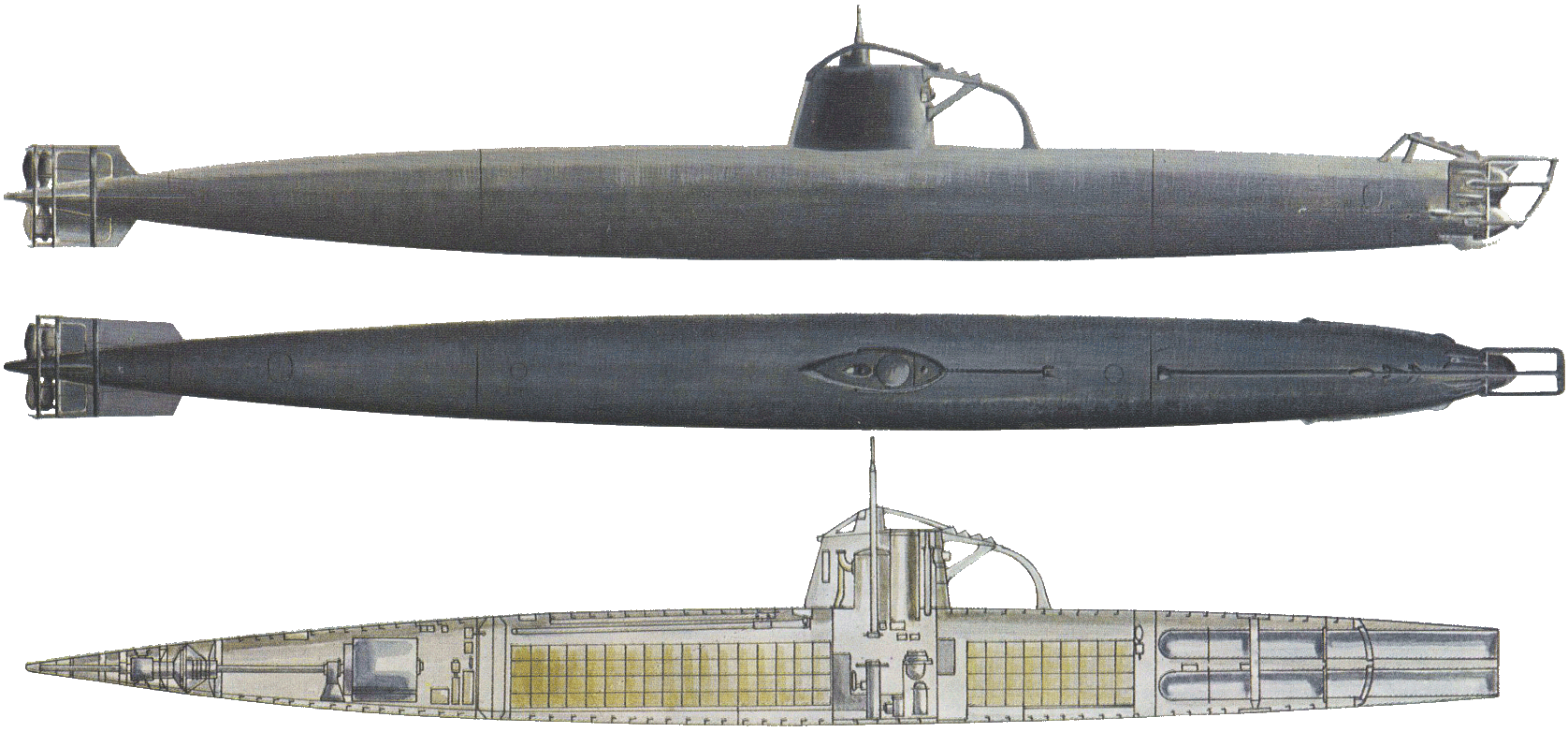
Japanese Midget Submarine. The Japanese began experiments with midgets in the mid-1930s and the Type A were used unsuccessfully at Pearl Harbor and against Sydney harbour in Australia. Their most notable success was the torpedoing of the battleship Ramillies in Madagascar in 1942. Displacement: 46 tons (submerged). Armament: Two 18-in torpedoes. Speed: 23 knots (surfaced), 19 knots (submerged)
Ironically, the last success of Japanese submarines was the most spectacular, and it occurred when all was lost. On 30 July 1945 the heavy cruiser USS Indianapolis, after shipping the first atomic bomb out to the Pacific, was steaming between Guam and Leyte. So accustomed had the US Navy become to the lack of enterprise shown by Japanese submarines that this valuable warship was unescorted, but her course took her across the patrol line of 755; Lieutenant Commander Hashimoto fired a full salvo of six torpedoes, and two hit, causing the cruiser to sink in twelve minutes. To punish the Americans further for their complacency it was three days before anybody noticed that, the Indianapolis had not arrived at her destination, and so 883 of her crew died in the US Navy's worst disaster at sea.
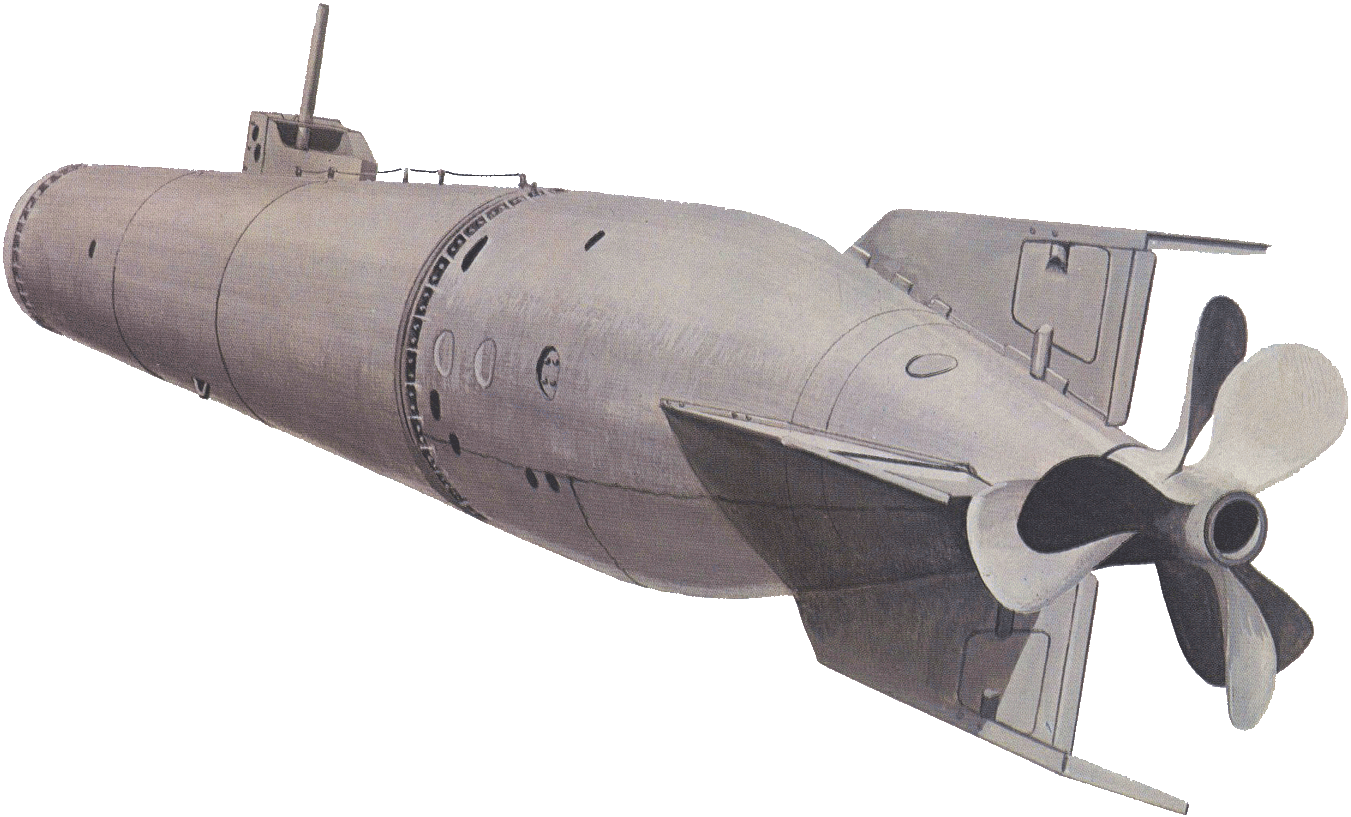
Japanese "Kairyu" Suicide Midget. The Type A midget was developed into a suicide boat, but production difficulties made it impossible to find engines or torpedoes for many of them. Over 200 were built. Displacement: 19¼ tons (submerged). Armament: Two 18-in torpedoes or a nose-charge of 600 Kg TNT. Speed: 17,5 knots (surfaced), 10 knots (submerged)
POSTWAR DEVELOPMENTS OF VICTORY
At the end of the Second World War, as at the end of the First, the victors were quick to examine and learn from the German and Japanese submarines they had captured. But it would not be long before even more remarkable advances would affect the submarine: the day of nuclear-propelled submarines, armed with missiles rather than torpedoes, was fast approaching
As soon as Germany had surrendered to the victorious Allies, teams of intelligence officers and submarine experts moved into German shipyards and naval bases to seize as much as they could. Naturally there had been widespread sabotage and destruction of material by bombing, but the British, Americans and Russians were able to locate examples of the Type XXI, and even the few Walther boats which had been completed. In addition the British and Americans had the pick of all the U-Boats which had been interned at Lisahally in accordance with the surrender terms. Similarly when Japan capitulated in August 1945 large numbers of Japanese submarines fell into Allied hands.
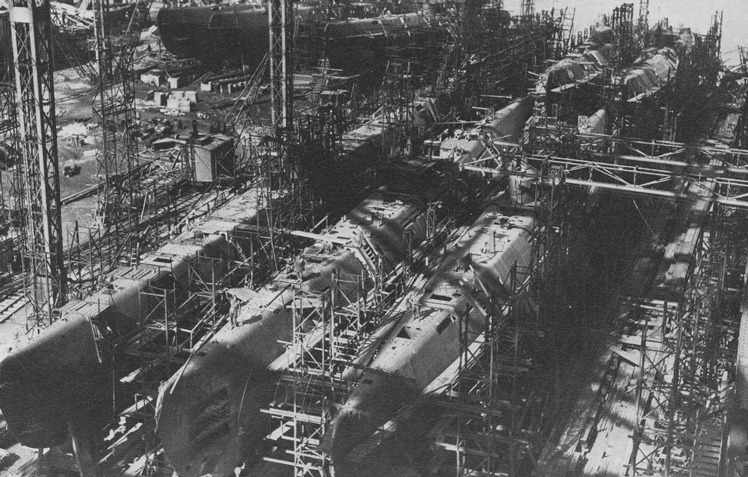
The Blöhm und Voss shipyard at Hamburg after its capture by the British in 1945. Submarines are in various stages of construction
Naturally, everybody was most interested in the Type XXI, as it proved to be a sound design. The Walther boats were treated with more reserve, mainly because it was going to take some time to find out how to work them. The Russians obtained some Walther hulls, and even went to the length of loading the incomplete aircraft carrier Graf Zeppelin with U-Boat hull sections in her hangar; their enthusiasm over-reached itself, and the towed hulk sank after hitting a mine in the Gulf of Finland.
All navies knew how close the Allies had come to defeat at the hands of the U-Boats, and so the years immediately after 1945 were marked by prolonged experiments in submarine design, and also in anti-submarine warfare. The Type XXI features, the streamlined hull and large battery capacity, were immediately incorporated into new designs. The deck gun began to disappear, for it caused too much drag, and the former bulky conning tower with its platforms and periscope standards was streamlined into a fin, known in the USN as a "sail". The schnorchel became a standard fitting, known in American submarines as a "snorkel" and to the British as a "snort".

Russian "W" Class. This class, like so many others, clearly owed much to the German Type XXI, and was probably begun as soon as Soviet designers had absorbed all the knowledge gained after the German surrender. The first units appeared in 1950 and about 200 were built by 1958. Many of these are now serving with satellite navies, and the class is obsolescent. Displacement: 1,030 tons (surfaced). Armament: Six 21-in torpedo-tubes (four forward, two aft) eighteen torpedoes carried. Speed: 17 knots (surfaced), 15 knots (submerged)
Propulsion remained the tried and proven diesel-electric drive for the moment, but the Walther turbine promised the dream of a "true submarine", independent of outside oxygen. The three major submarine powers, Great Britain, the United States and Soviet Russia all experimented with the idea, although the Americans soon decided to drop it because of its complexities. The Russian experiments remain shrouded in secrecy to this day, although it is known that Walther-engined boats were tested. The British ran the salvaged U1407 as HMS Meteorite from 1946 to 1950. She was regarded as about 75 per cent safe, and her crew were doubtless thankful to see the last of her. But she spawned two improved versions, the 225-ft Explorer and Excalibur, which entered service in 1956-58.
These two submarines were not unnaturally known as the "blonde" submarines because of their peroxide fuel. They served a useful purpose in as much as they gave the Royal Navy's anti-submarine forces some valuable practice against fast targets. Their main use, however, was to prove finally that the Walther system was only a stopgap. There was more than one contemporary report of explosions in the two submarines, and at least one instance when the entire crew was forced to stand on the casing to avoid the noxious fumes which had suddenly filled the boat.
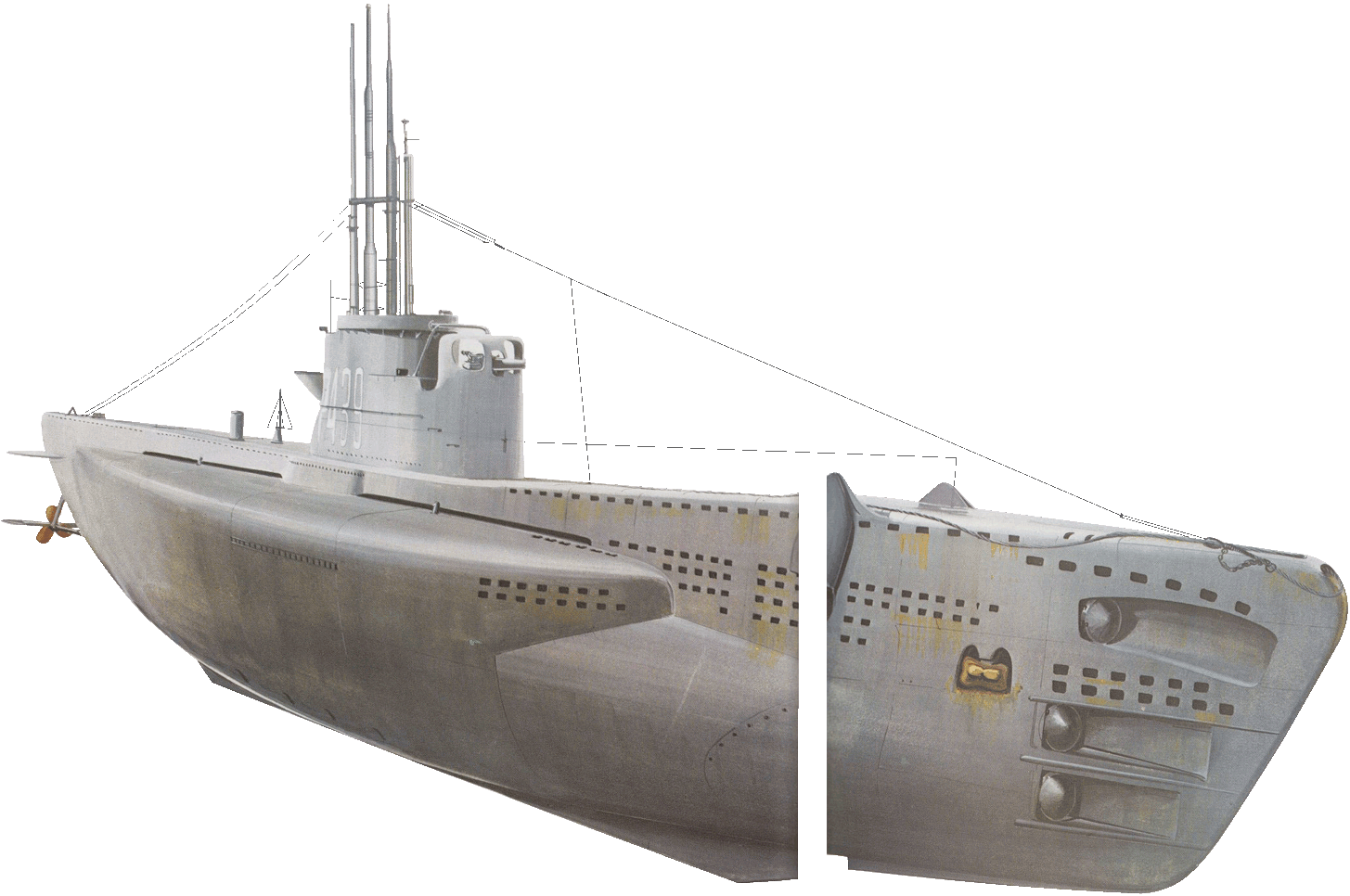
British Amphion. For the Pacific, the Royal Navy needed a larger submarine with more endurance, and the "A" Class resulted. They were not as large as the American boats, but they had air-conditioning and a radius of action of 10,000 miles. The early boats like Amphion had a low bow, but after trials this was raised
The reason the Americans had been so lukewarm towards the Walther system was that they had practical experience of nuclear energy. When the war ended the only use made of nuclear power had been in the form of bombs, but it was clear that a controlled reaction would be feasible. Nuclear energy provides a limitless source of heat, and makes no demands on oxygen for combustion. The disadvantage was merely that of weight and size, for a reactor needs thick lead shielding to prevent radiation, quite apart from its bulk. Therefore American nuclear physicists bent their research towards producing a reactor small enough to power a submarine.
While the designers were groping towards nuclear propulsion, the immediate problem for the US Navy was to modernise their submarine fleet to incorporate all the lessons of the war. A number of the Tench Class were completing to a slightly improved Balao design, and they were altered. The new design was known as the "Guppy" type, standing for Greater Underwater Propulsive Power, and incorporated a lengthened and streamlined hull with larger batteries, as well as a modified sail and snorkel.
Many of the older Gato and Balao classes were converted in similar fashion, but even more were allocated to experimental duties.
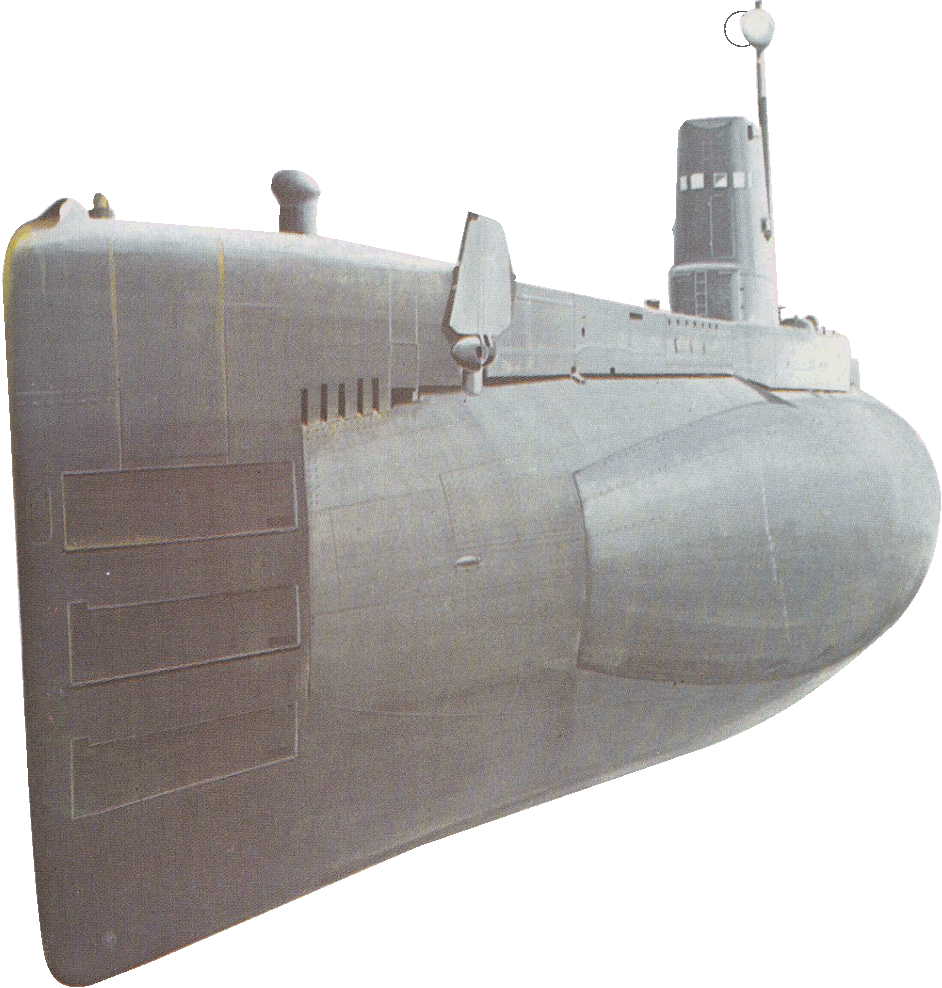
British Tireless. The early "T" Class had riveted hulls, and therefore they could not be fully modernised. The later ones, like Tireless, were given a form of "guppy" conversion in 1951-56, being lengthened and streamlined to give greater speed and endurance. Displacement 1,280 tons (surfaced). Armament: Six 21-in torpedo-tubes (guns and after tubes removed). Speed: 15 knots (surfaced), 15 knots (submerged)
Every wartime idea was tried and developed, including oilers and supply submarines. In 1948/49 the Carbonero and Cusk were fitted to operate the "Loon" guided weapon system, an improved version of the German V1 "doodlebug", launched from a catapult abaft the conning tower. From these experiments came the Regulus I missile, an air-breathing anti-ship missile with a 500-mile range, and the Tunny and Barbero were fitted with cylindrical hangars to house two missiles.
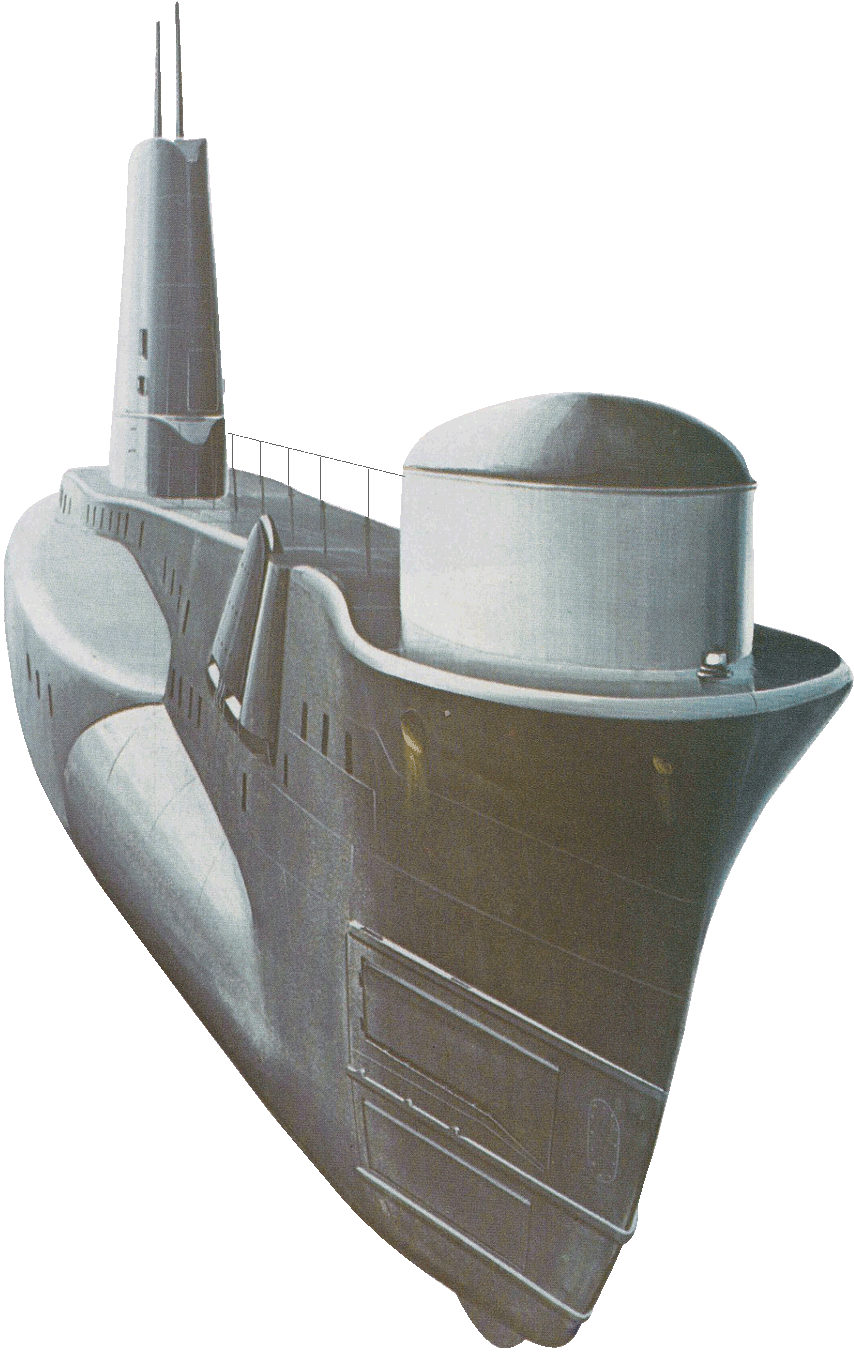
British Alaric. The "A" Class were given a modernisation on the same lines as the "T" Class, involving a complete rebuilding of the forward and after sections of the hull, lengthening and streamlining. The two external tubes forward and the two aft were removed, leaving them a total of six tubes, and no gun armament
The Regulus II missile which followed was 57 ft long, compared with only 32 ft for Regulus I, so it demanded a much bigger submarine. The Grayback and Growler, built in 1952-58, were fitted during construction with enormous twin cylinders faired into the forward casing. The nuclear Halibut was designed in 1956 to fire Regulus II as well, but after five years in service it was announced that the Regulus II programme was to be abandoned; she and the two conventionally powered Regulus-armed boats were disarmed. However, their massive missile compartments made them useful for other purposes, and Grayback is currently serving as an amphibious transport, while Halibut is acting as a "mother ship" for the Deep Submergence Research Vehicle programme.

Russian "G" Class. This was an improved version of the Z-V Class, with three ballistic missiles. The 22 boats of this class now have the 650-mile range Serb (SS-N-5) missile in place of the older Sark, and an additional unit of the class was built in China
During the Cold War period the United States was preoccupied with the threat of Russian air attack with nuclear weapons, and put great faith in a seaward early- warning radar "picket line". Most of the pickets were surface warships fitted with elaborate radar and communications, but several submarines were fitted out as radar pickets to provide more flexibility. This led to the construction of an enormous nuclear radar picket submarine, the Triton. She was the largest submarine ever built at the time (1959) and had two nuclear reactors; this power enabled her to circumnavigate the world submerged in 1960, a 41,500-mile voyage at an average speed of 18 knots.

Russian Z-V Type. Between 1958 and 1961 seven of the conventional "Z" Class were rebuilt to fire two ballistic missiles. This was part of a crash programme to counter the US Navy's sudden breakthrough in perfecting the Polaris system, but unlike the American boats these Russian conversions had to launch their missiles on the surface. None are now operational
All this time Russia's submarine force remained an enigma. Armed with as much information about German developments as her technicians could get, she worked hard to modernise her fleet. By the early 1950s the first of the new "W" Class were seen;although claimed to have been started in 1944 it is clear that they owed a lot to the Type XXI. They became the standard postwar type, and many were transferred to other navies. In 1961 work began on converting twelve to missile-firing submarines on the lines of the American Tunny and Barbero. One boat carried a single Shaddock surface-to-surface missile in a cylinder which elevated 20-25� for firing, but others carried twin cylinders, and the third variant carried four Shaddock cylinders faired into a streamlined fin. There was also a radar picket version.
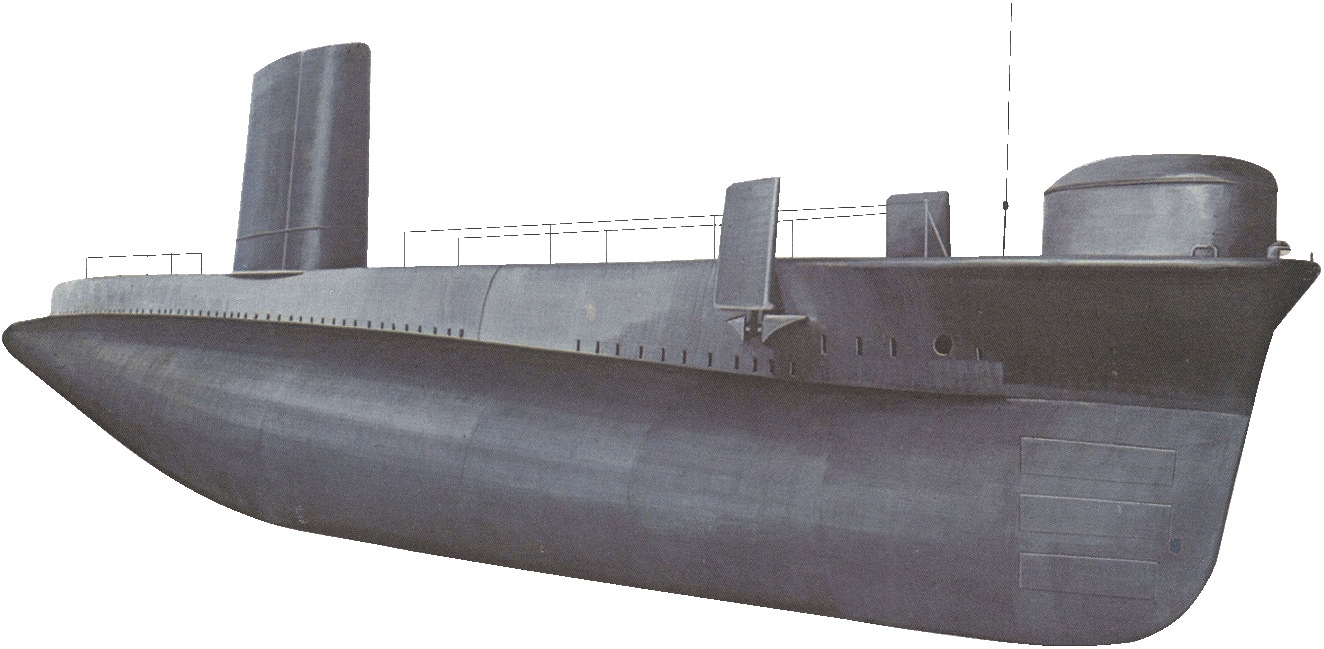
British Oberon Class. The thirteen Oberons are the Royal Navy's latest conventional submersibles, and also its most successful export design, as a number have been built for other navies. They embody many features of the German Type XXI, and have the reputation of being the most silent submarines in service. Displacement: 1,610 tons (surfaced). Armament: Eight 21-in torpedo-tubes (6 forward, 2 aft); 30 torpedoes carried. Speed: 12 knots (surfaced), 17 knots (submerged)
The next Russian submarine type to appear was the Class, whose existence was doubted until 1952, when the first blurred photographs appeared in Western magazines. This was the class which was reputed to have tried the Walther propulsion system in the first few units, but the remainder quickly reverted to diesel-electric propulsion. They were more closely related to the Type XXI than the previous class, and at least 25 were built. A further ten were converted to fire two ballistic missiles from vertical tubes in the fin, and a slightly enlarged version called the "G" Class was built at the same time to fire three missiles.

Russian "J" Class. This class of conventional submersibles carry four Shaddock surface-to-surface cruise missiles in launchers housed in the deck casing. Sixteen were completed by 1967
Great importance was attached in Western newspapers throughout the 1950s to the size of the Russian submarine fleet, but at the time its numbers were swollen by the large number of obsolescent "M", "S" and "Shch" Glass and other boats which had survived the Second World War. When the new construction came into service it was possible to pay off these old submarines, and by the end of the decade it is doubtful if any were still used for anything but training.
We have much more interesting information on this site.
Click MENU to check it out!
∎ cartalana.com© 2009-2025 ∎ mailto: cartalana@cartalana.com